This post is our itinerary for a three-week road trip in Georgia (the European country in Caucasus). We travelled to Georgia for three weeks in July 2019. Starting in Tblisi, we went hiking in Greater Caucasus, and stopped in Gori, Kutaisi, the Black Sea coast and Vardzia.
Using the map: Use the mouse to zoom and pan. Click the button in the top-left corner to open a navigation menu. There you can select or de-select specific types of content we have added to the map.
Our itinerary
We flew in to Tblisi, spent a few days there before renting a car for the rest of the trip. We booked all accommodation in advance on booking.com.
From Denmark, there are no direct flight, and all flights arrive in Tblisi in the middle of the night. It’s not the ideal start, but there were no alternatives.
This itinerary includes a four-day village-to-village hike in the Svaneti region the Greater Caucasus mountains, from Mestia to Ushguli, read about that hike here.
- Day 1-3: Arrive in Tblisi, explore the city
- Day 4-6: Drive to Stepantsminda in Kasbegi, Gergeti Trinity Church and dayhike in Sno valley to Mount Chaukhebi in Greater Caucasus
- Day 7-8: Drive to Kutaisi, visit Uplistsikhe and Gori (Stalin’s birthtown) on the way. Sataplia Nature reserve
- Day 9: Drive to Mestia, the hub of mountain tourism in the Svaneti region of Georgian Greater Caucasus
- Day 10-13: The famous Mestia to Ushguli hike – a highlight despite terrible weather
- Day 14-15: Drive to Shekvetili on the Black sea coast, Kolkheti national park
- Day 16-18: Drive to Vardzia, Vardzia caves
- Day 19-20: Return to Tblisi and fly back to Denmark
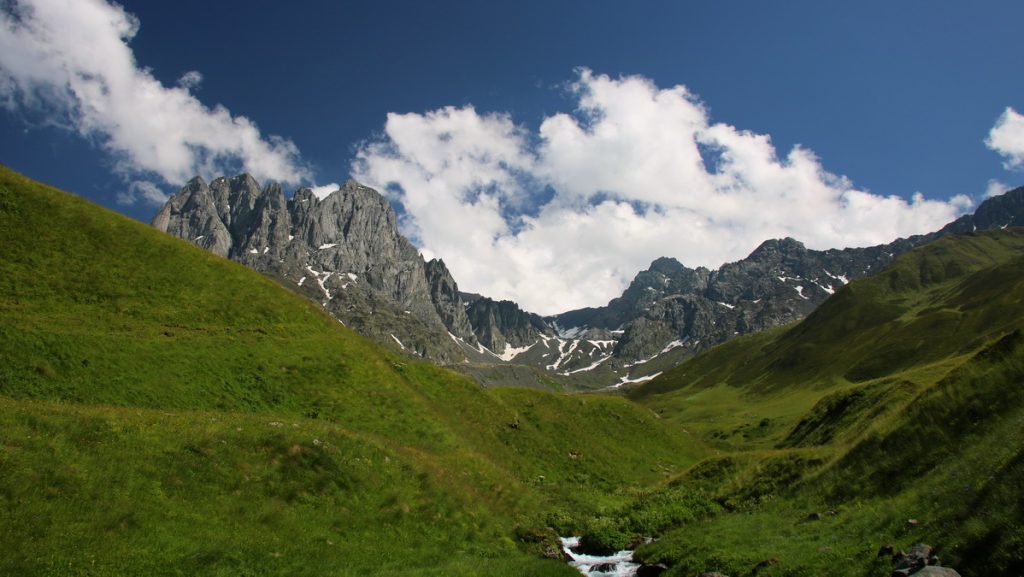
Why we decided to visit Georgia
When do travel ideas turn into concrete plans? We had talked about visiting Caucasus for some years. It became reality for us when we saw photos from village-to-village hikes in Georgias Greater Caucasian mountains in Svaneti!
Those mountains offered exactly what we wanted to include in a summer vacation trip: well-marked paths, high alpine terrain, day hikes between 10 and 18 km and a sense of adventure in a less-travelled corner of the world.
And we quickly realised that there is a lot to do in Georgia. So instead of trying to cramp Armenia or Azerbaijan into a fast-paced trip to the highlights of Caucasia, we decided to lower the pace and take the time to get a better feel for Georgia.
You can go to Georgia for the good food and the long history of wine, for the long Christian history and the many churches and monasteries. To enjoy the sun at the Black sea. Or to explore a country with a rich and complex history, having been a part of the Osman, the Persian, the Russian and Soviet empires.
We went there for the mountains, the diverse nature in the Greater and Lesser Caucasus, the sun, and for the sense of adventure it gave us to visit a country on the border between Europe and Asia. To visit a country that seems far away to many Western Europeans, but where the inhabitants feel very European and the atmosphere is more like Italy than Russia.
We researched hiking routes and found that the four-day route from Mestia to Ushguli in the remote Svaneti region resonated best with our family. It is beautiful, well-marked and safe, and can be done with light backpacks because you sleep in guesthouses in the villages on the route. It is a great hike and highly recommended!
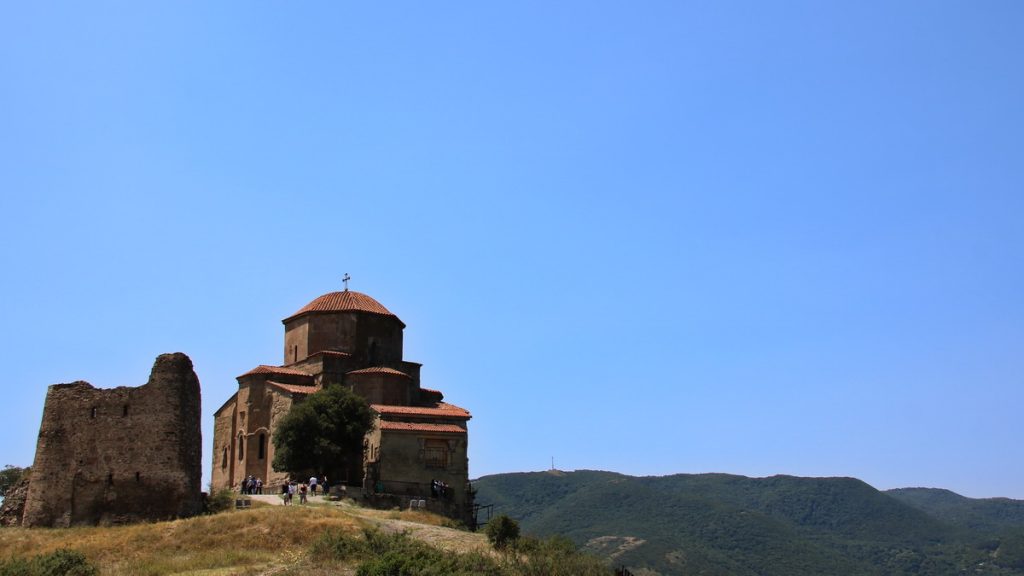
Day 1-3: Tblisi
Our flight from Copenhagen to Riga was delayed, so we sprinted through Riga airport in the middle of the night to catch the onward flight to Tblisi. Our luggage didn’t make it. Going through immigration in Tblisi took almost two, long hours. We bought a Magti SIM card (it has the best coverage) in the arrivals hall before finding the driver we had booked with the hotel. The driver had been wondering where we were, normally the waiting time through immigration is shorter.
We drove through Tblisi with the first light of day. The roads were wet as it had been raining. Tblisi is in transformation, some areas are run-down, some are shiny new.
We had booked three nights in the old city at “Castle in old town”. It was the perfect place to relax and start the vacation. It is converted from the ruins of what was the private home of a high-level official of the Ottoman period. It sits on the hills above the city and has a small pool with a fantastic view over the city. The restoration of the hotel has been done with the best materials and skilled craftsmen and is decorated with the private art collection of the owners. The staff is very helpful and friendly. We immediately felt at home and would love to stay here again.
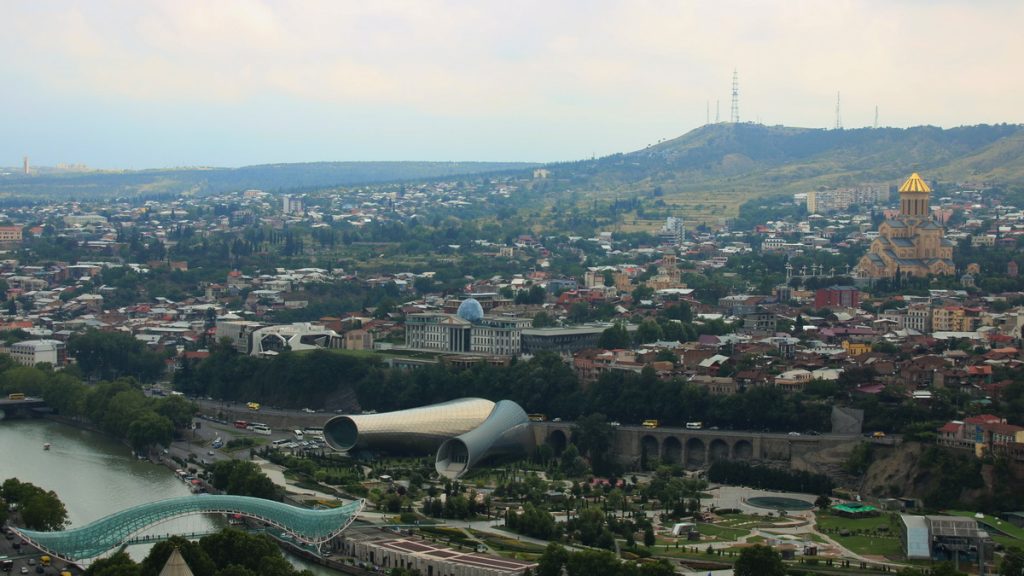
We spent the first day getting a feel for the city. The old city is like any medieval European city with narrow, winding streets, lots of atmosphere and full of restaurants and hotels. People are friendly and we felt at ease. Many of the beautiful 100-year old buildings are empty and in very poor condition, others have been renovated. A diverse city!
Georgia has a unique alphabet with letters that reminded us of east Asia. It is totally uncomprehendable to us but luckily traffic signs and all other texts we needed to understand are also in latin letters.
From Castle in old Town we could take the walking path to the large statue Mother of Georgia and further to the Narikala fortress which overlooks the city. There are great views from there. We didn’t spend much time in the fortress itself, there isn’t much left of it except for the walls.
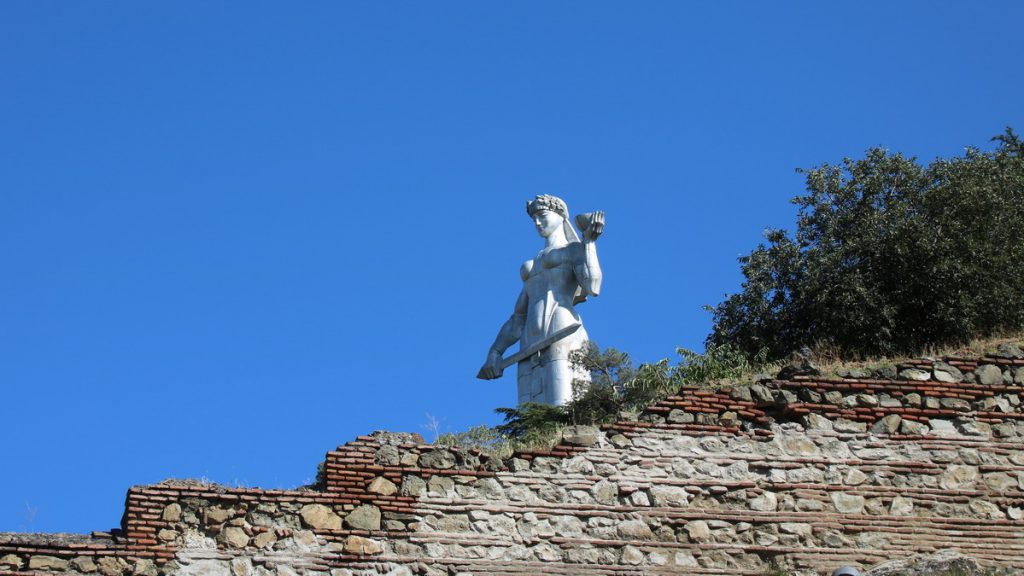
We wanted to see some of the churches, but the kids were not into that. We agreed to visit one, the Metekhi church opposite the Narikala fortress. Georgia has its own variant of orthodox Christian theology, but as a casual visitor it wasn’t obvious how to recognize this.
History and politics are visible everywhere in the public realm, with the central Europe square at Rike park as a good example. There are Georgian flags next to the flags of the European Union, and posters explain the geographical and cultural relations that make many Georgians feel deeply European.
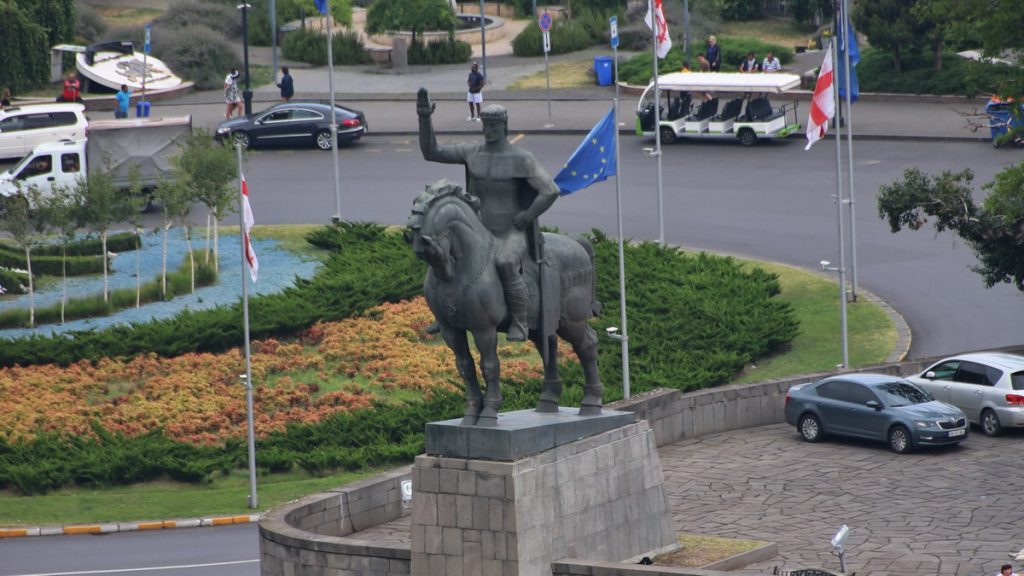
Rike park is a very nice place for a stroll and an icecream. From the park you can cross Mtkvari river on the recent Peace bridge, one of the space-age architectural structures that provide a strong contrast to the rest of the old city of Tblisi.
We had dinner both nights at restaurants in Erekle il street. It has a great cozy vibe. There are many bars, but we easily found family restaurants.
We had unusual weather, as it was partly overcast, and not over 25°C, usually it would be sunny and 30-40°C. The locals had never experienced anything like it, and attributed it to climate change.
You will find the same typical Georgian dishes everywhere we go. As almost-vegetarians with a celiac among us, eating in Georgia was both delicious and easy! We had lots of Lobio (black bean soup) and Lobiani (black bean pie). Bread and cheese is part of many of the traditional dishes.
See our experiences travelling gluten free in Georgia
Day 4-6: Drive to Stepantsminda, hiking in Kasbegi and marveling at the Gergeti trinity church
We picked up the rental car from Avis and were ready for the mountains.
See our experiences renting a car and driving in Georgia
The views are amazing, so if you are not in a hurry, you’ll enjoy the ride. We made a stop at the Jvari monastery just outside Tblisi. It is built on a hilltop and is just plain beautiful. The church-builders in Georgia really had a knack for finding the most scenic locations.
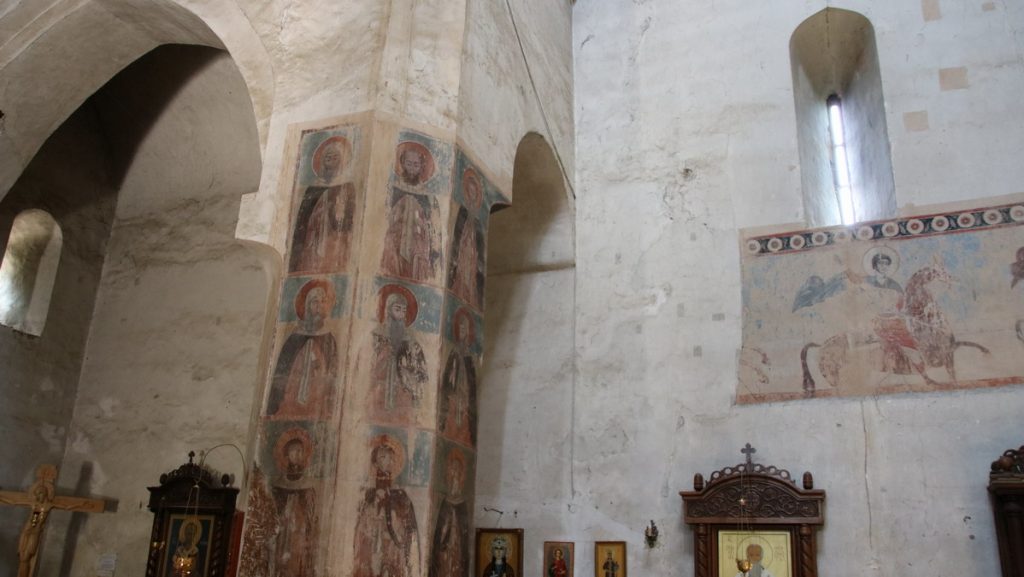
Continuing north, you drive on the military highway, named so because it was used by the Russian empire in the 1800’s in the many wars to conquer Caucasus and the lands to the south.
Further on we stopped at the Russian-Georgian friendship monument from the Soviet era. The views to the valley and mountains are great and worth the stop, the monument itself is more special than beautiful. You can do tandem paragliding, but we skipped that from lack of time.
The town of Stepantsminda is the gateway to the mountains of Kasbegi, the part of the Georgian Greater Caucasus that is easiest to access for tourists from Tblisi. It looks like it has been a quiet border town until recently. Only a few of the roads are paved, there are no sidewalks, and it is by no means a pretty town. Many new hotels have been built and tourism seems to drive development. It is fun to see the contrasts, like the old Soviet era trucks besides new cars.
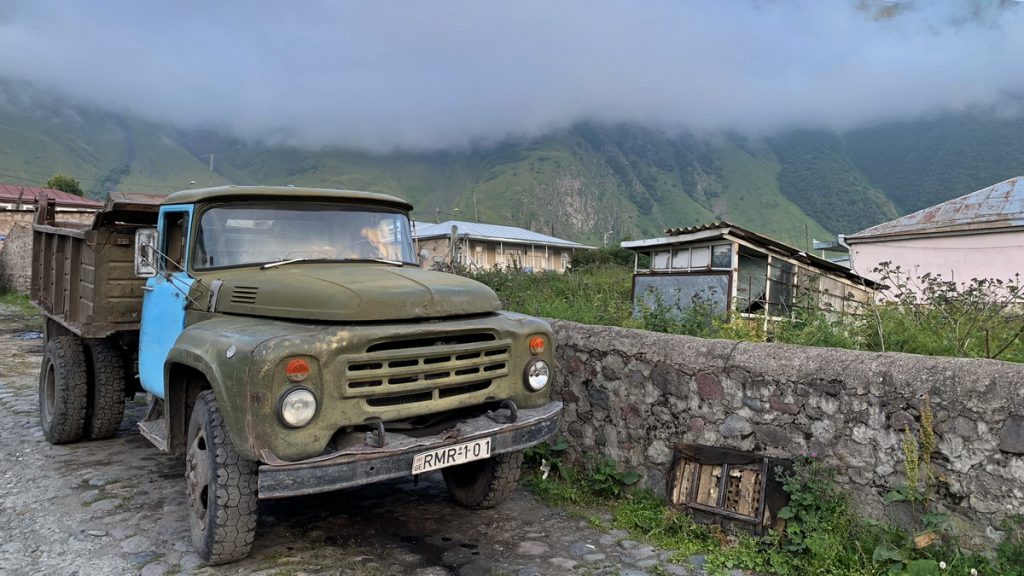
We had booked a family room in Hotel Green Sheep. It is a new hotel and we liked the style of it. The staff was not making an effort, and the restaurant isn’t great. We had dinner one evening at the Rooms hotel, which we would stay at if we came back. It’s a huge building, renovated with a touch of luxury. And then it has the best view in town to the top attraction of Stepantsminda: the amazing view to the Gergeti Trinity Church.
Gergeti Trinity church is on a mountain top above the city and has mount Kazbek in the background. It is simply iconic and beautiful, it’s a view that we wanted to enjoy us long as we could.
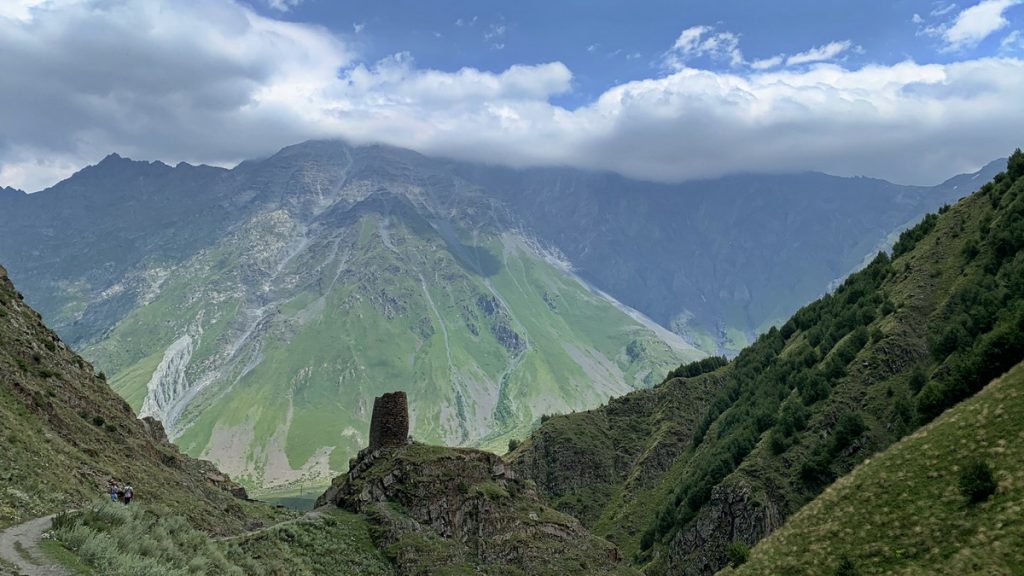
We hiked to the church from the small village across the river from the main square of Stepantsminda. We drove the car to the end of the village where the trail starts, the trail is easy to follow. It’s an easy round-trip of 2-3 hours. The church isn’t interesting in itself, it is the silhouette against Mount Kazbek that is the main attraction. The hike is beautiful, and definitely recommended.
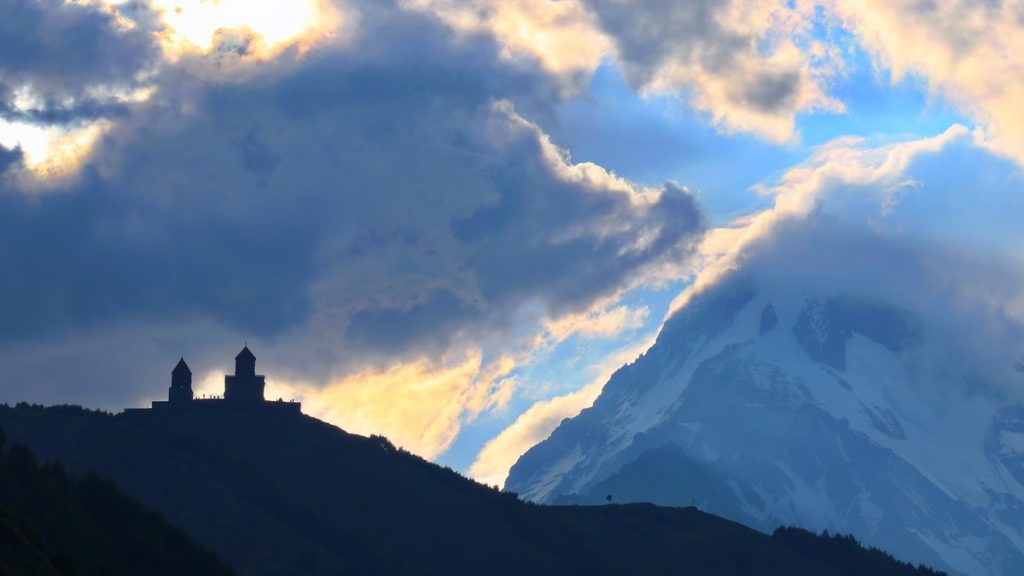
If you’re ready for an even more spectacular hike, you can take the car all the way to the church, park there, and hike towards Mount Kazbek. We saw many walking that route as a day trip.
We ended the day hiking to the nearby Gveleti waterfalls. It is a short hike to two beautiful waterfalls in dramatic landscapes of the Caucasus.
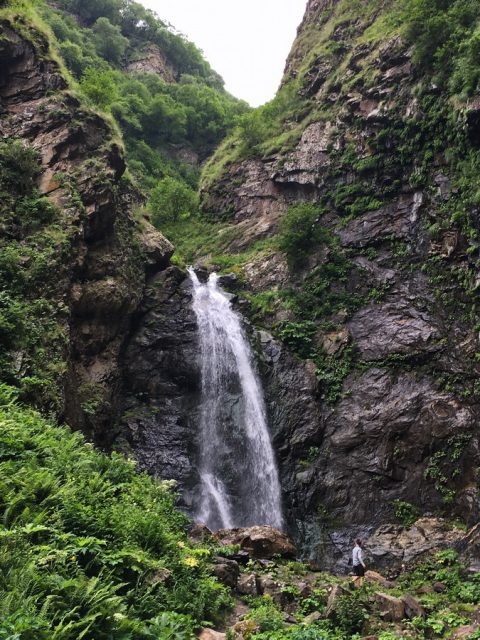
The next day we drove into Sno valley and hiked from the village Juta. The trail is easy to follow. It is steep as you leave the village but after a km or so the trail flattens as you enter the green Chaukistskali river valley. It is high alpine mountain country, but green and with many more flowers than we would expect in the Alps. Green and colorful at the valley floor, with the steep mountains to either side.
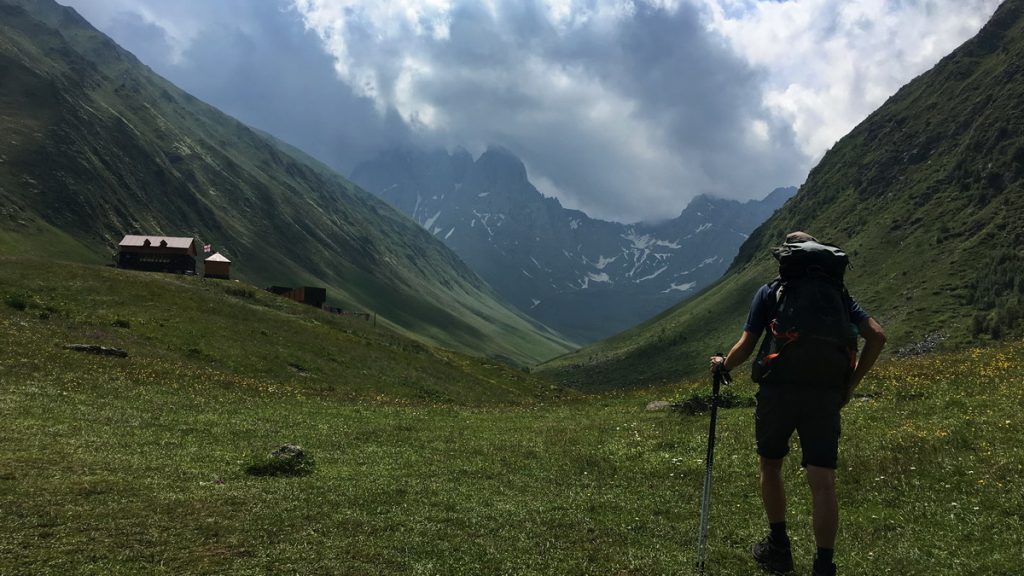
We followed the trail which passes several small cafes and a mountain huts with rooms for rent and the option of pitching your tent outside. The day started cloudy, but in the afternoon we had mainly blue skies. The trail leads towards Mount Chaukebi, a lone granite peak with a characteristic profile. That hike was exactly what we had hoped to find in Kazbegi!
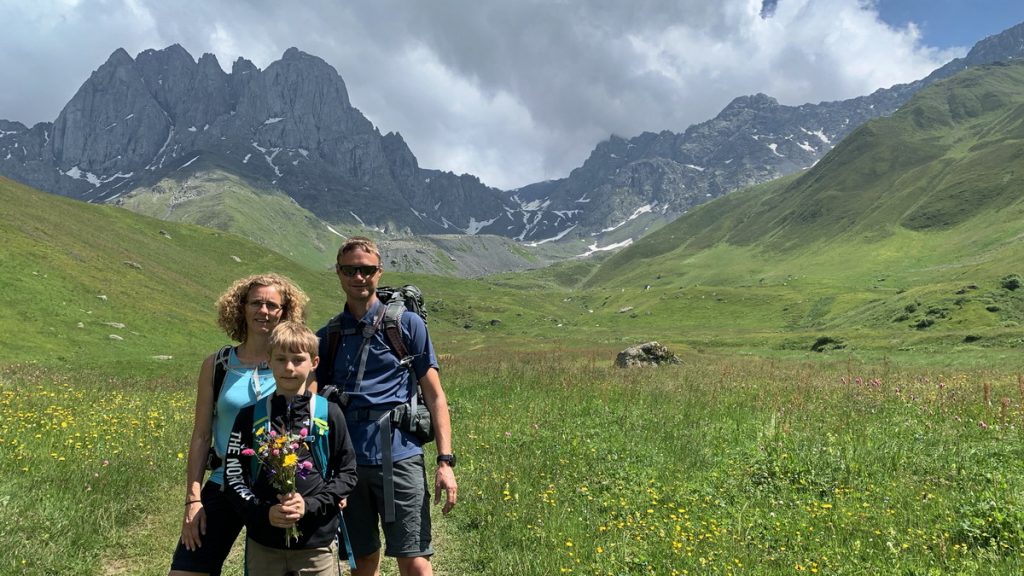
On the way down we picked flowers and played in some of the snow fields you cross in the trail. We have a family tradition to always find snow on our summer travels.
Day 7-8: Uplistsikhe, The Stalin Museum in Gori, Soviet era spa resort in Kutaisi and Sataplia Nature Reserve
Leaving Stepantsminda, we backtracked down the military highway before taking the main eastern highway of the country. The highway passes south of some of the Russian-occupied parts of Georgia. There are no signs of conflict, but it is a very real reminder that not all parts of the world are as peaceful as Scandinavia.
Stalin Museum in Gori
Gori has its fame for being the birthplace of Soviet dictator Stalin, and the town has a huge museum about Stalin. We stopped to see it and have lunch in Gori, but didn’t visit the museum, which is supposed to mainly paint a fairytale image of Stalin.
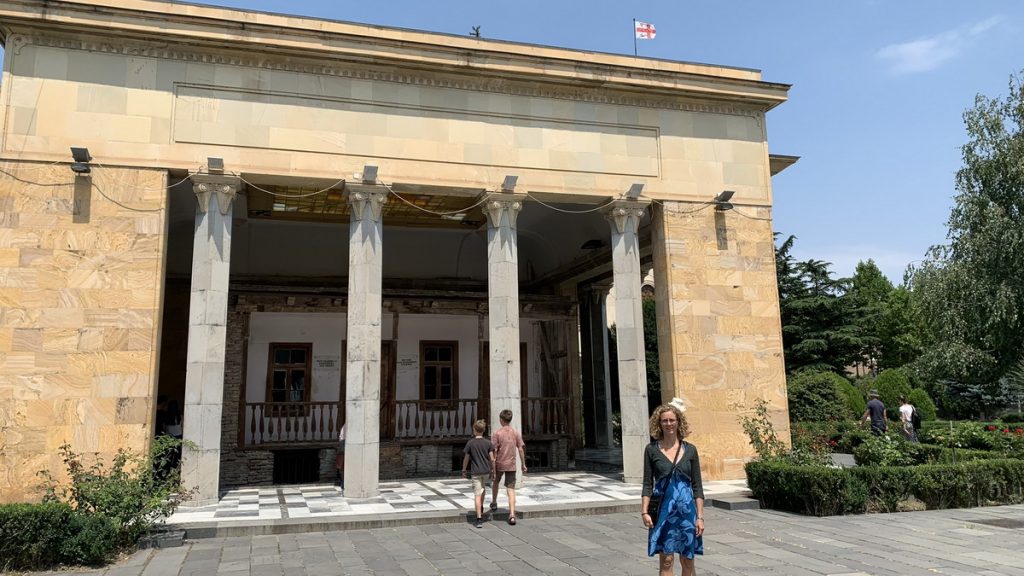
Ancient cave city of Uplistsikhe
What we found much more interesting is the ancient cave city of Uplistsikhe, just outside Gori on the Mtkvari river. The city is carved into the rocks and is essentially a huge complex of caves used for dwelling with defensive systems around. There is not much information on the history of the site at the complex, but it is well organized and a fun and interesting place to visit. The kids loved running, climbing and jumping their way around the many streets, plazas and caves.
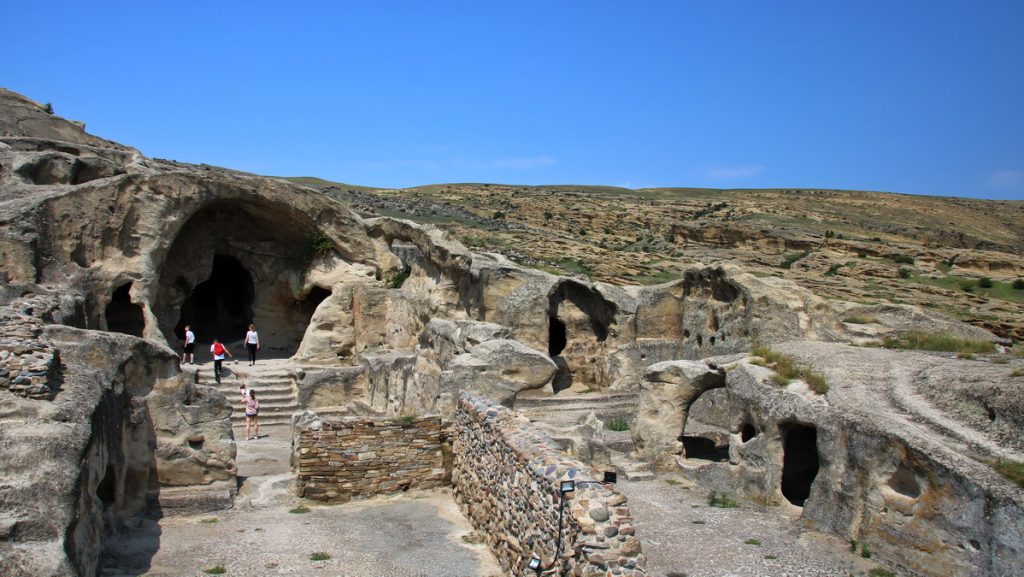
We continued towards Kutaisi on the main highway which as this point was reduced to a single lane road with lots of traffic, and passing one village after the next. It was rainy while we drove there, and the villages are not anything near pretty. Kutaisi is a big regional city with lots of Soviet era housing blocks that are in use but appear not to have been maintained in decades.
In the outskirts of the cities there are unused and unmaintained buildings of poor quality everywhere you look. Some are interesting but most are just waiting to be removed.
Outside Kutaisi is Tskaltubo which was a spa resport town for the Soviet elite. We had booked two nights at Tskaltubo Spa Resort, a huge, pompeous structure. We realized that only a small part of the complex had been renovated and opened as a modern resort. It was built to impress and enormous! But it was also poorly built and damaged by moisture everywhere. The weather was cloudy and moist while we were there, and the rooms just felt plain humid.
The pool area is fine. We had both breakfast and dinner, and it was quite bad, reminding more of a Soviet cafeteria than a modern hotel.
Sataplia Nature reserve
There is a lot of day trips you can do from Kutaisi. We went to the Sataplia Nature Reserve. We found out that you can not go there alone, you need to join a guide tour which leave every hour from the visitor centre. Some tours are in English, others in Russian, and the first one after we arrived happened to be in Russian. The friendly guide supplemented with a bit of information in English for us.
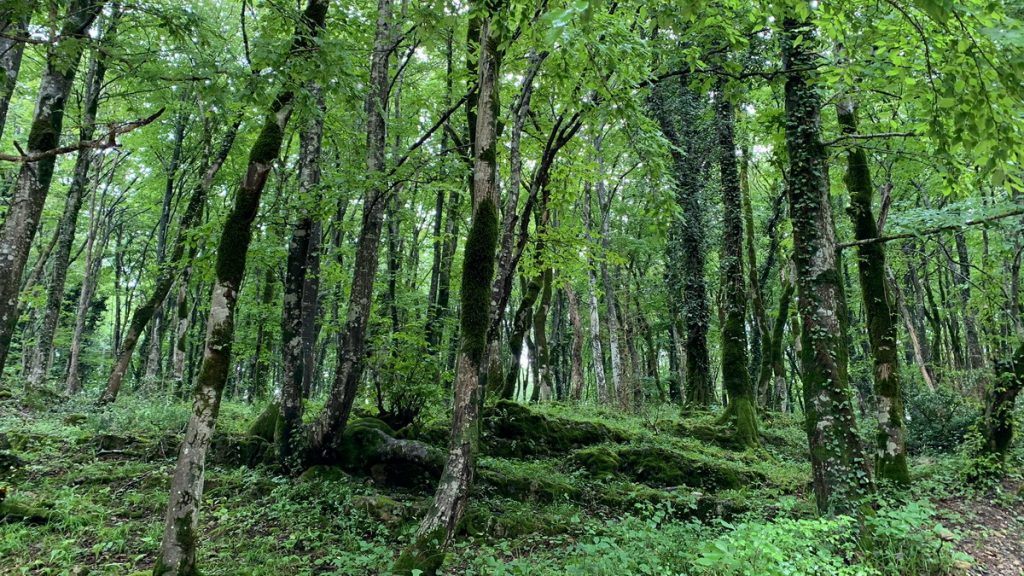
The reserve is definitely worth visiting. You start the tour at the site where dinosaur tracks were discovered recently. From there you go into a large, lit cave with stalactites. The reserve is home to the rare Colchian forest and has walking paths going through this. A glass-and-steel platform gives a panorama view of the forests below and on clear days it must be possible to see very far.
We had originally planned to go for a day to Okatse canyon, but food poisoning kept Peter at the hotel, so the rest of the family took an easy day.
Day 9: Driving to Mestia, the hub for mountain activities in the remote Svaneti region of Greater Caucasus
Google “Svaneti”, and you will see colorful stories of terrible roads and proud, inhospitable locals with a long tradition of not treating strangers with kindness. It is also a region known as a hub for activities in Greater Caucasus, and therefor we wanted to include Svaneti in out itinerary for a three-week road trip in Georgia.
We had no bad surprises going to Mestia, in fact quite the opposite. Prepare for a long, winding mountain road. Traffic was light when we went there, with only a few trucks.
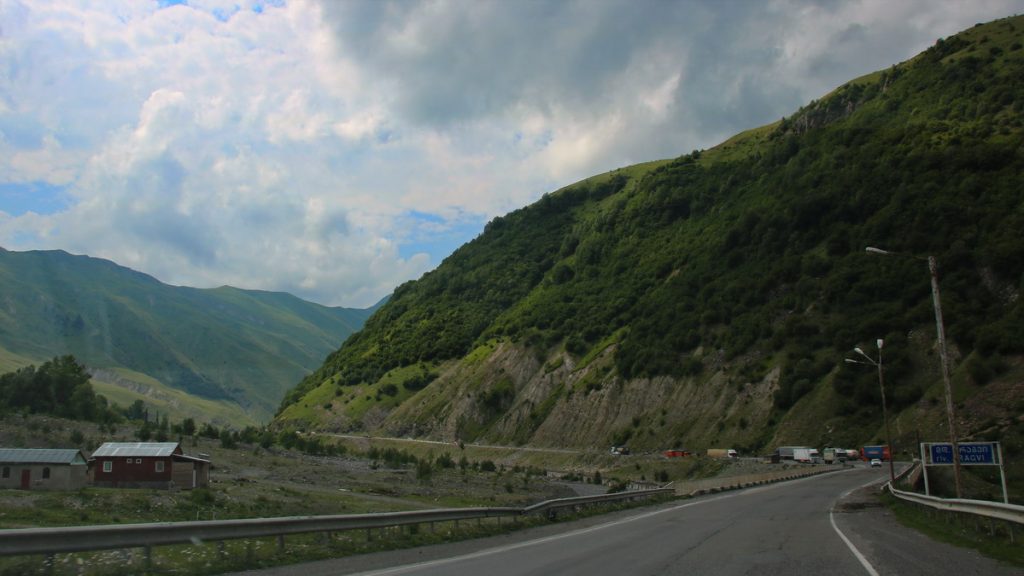
It is a very beautiful drive along the Patara Enguri river, so plan time for plenty of photo stops. As you enter the Svaneti region, you will see many of the iconic Svan towers in all the villages. They were built by families and clans hundreds of years ago for housing and protection in clan blood feuds. They look completely identical and is the most visible sign of where you are in the world.
We arrived in Mestia in the afternoon and found our family room at the family-run Villa Mestia hotel. It is an old building set at the main street into town. It has a lush green garden with lots of roses. Our room had a large balcony overlooking the garden. The room itself was simple and clean. Everyone at the hotel were very friendly. It was a good base for our hike. We could store luggage while hiking, and one of the family members had a minibus and we arranged that he would meet us in Ushguli after the hike and drive us back to Mestia.
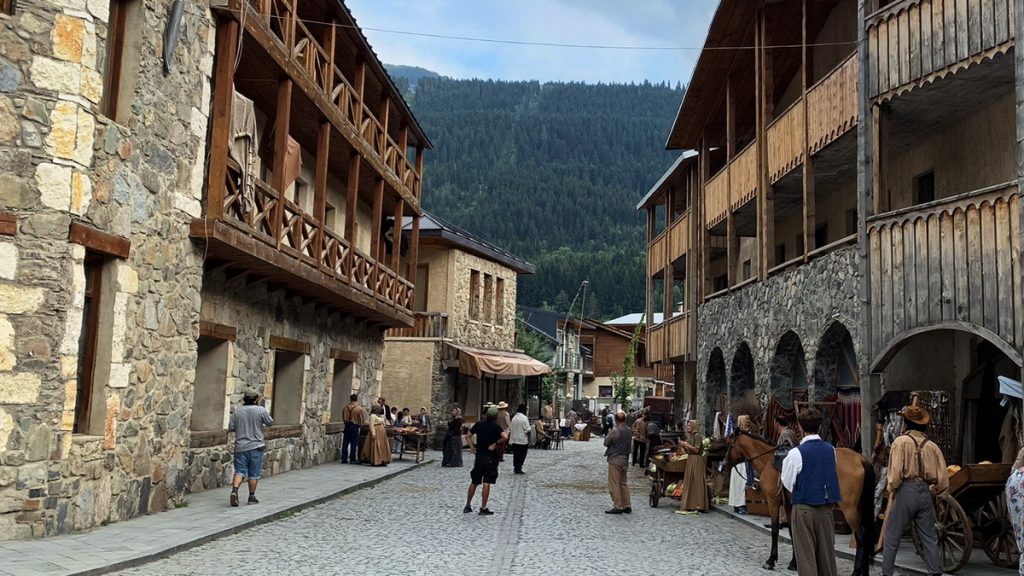
Mestia has an atmospheric city centre with a lot of restaurants and hotels, it was not the rough mountain town we were prepared to see. We enjoyed the evening there but were surprised by torrential rain as we were ready to walk back to the hotel. We ended up with wet clothes and had to be creative to dry it before our hike started the next morning. We laid out the wet clothes across the car seats and packed what we needed for the four-day hike.
We would have breakfast and dinner at the guesthouses and assumed we could also find what we needed for lunch, so we only needed to bring a few snacks and some gluten free bread for Tobias.
Day 10-13 The four-day village-to-village hike from Mestia to Ushguli in Svaneti, Greater Caucasus
The hike from Mestia to Ushguli was what we had looked forward to the most. It is not a technical or difficult hike. You can buy maps in Mestia and find .gpx files for download online before you start. It is easy to find the right trails. The trails are well-marked. You’ll meet other hikers, but we walked alone most of the time.
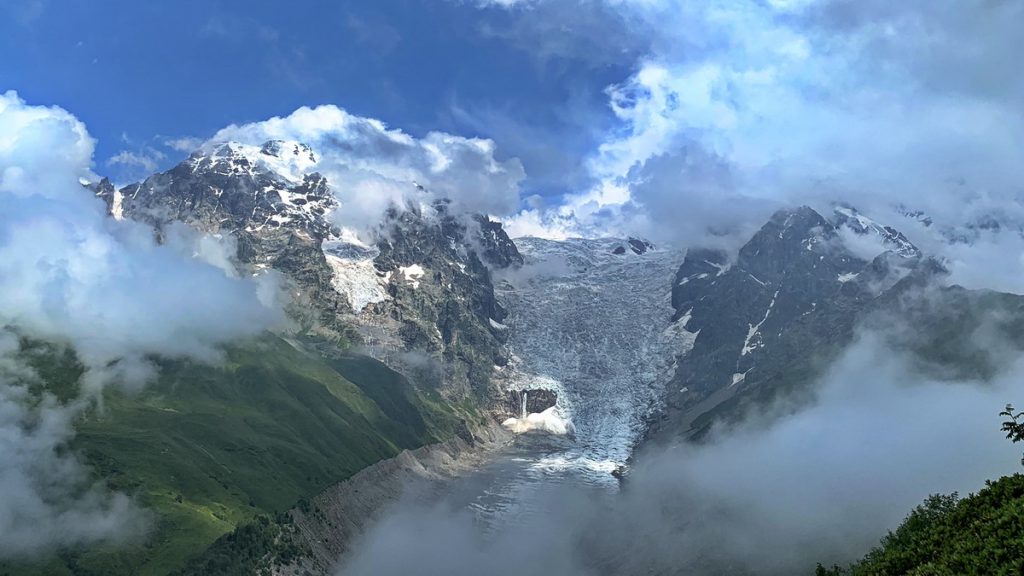
See our detailed description of the hike here.
We stayed again at Villa Mestia hotel before and after the hike.
Day 14-15: The Black see coast and a visit to a local hospital
We left Mestia in the direction of the Black Sea coast. After having followed the mountain road we had driven towards Mestia four days earlier, we reached the open lands of western Georgia. The weather had changed to typical warm Georgian summer weather and we enjoyed the blue skies.
The road passes Kolkheti national park, and we stopped in the visitor centre. Kolkheti national parks protects the wetlands at the shore of the Black Sea because it is a habitat for many species of birds, sharing similarities to Point Reyes National park in USA. The national park rangers arrange boat tours into the park, and we arranged a tour before continuing to our hotel.
We reached Kolkhida resort and Spa in the afternoon. The hotel is on the northern part of the Geaorgian Black Sea coast near the city of Ureki, and dominated by Russian tourists. It was the part of Georgia where English was spoken the least on our trip.
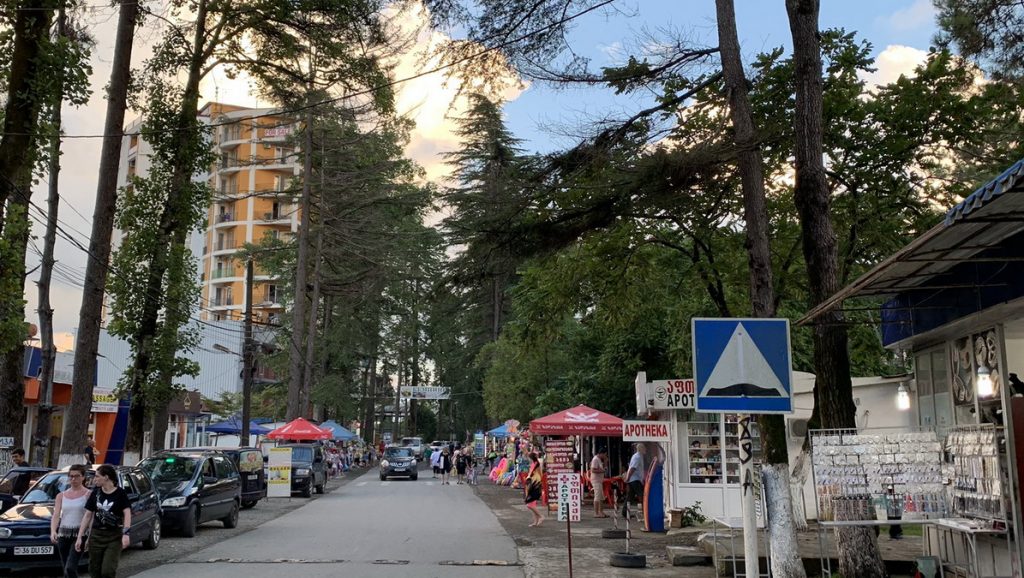
We felt that it was busy and crowded, and ugly without any charm to compensate. The staff at the reception of Kolkhida Resort and Spa were friendly, and when we asked if our room had sea view, they immediately upgraded us to a large suite with the best view the hotel could offer. Kolkhida Resort and Spa was a disappointment, it seemed to be a poorly built structure that was not maintained well. The shower heads in the bathrooms were broken and the toilet seats were loose, and the doors didn’t lock properly. The buffet for dinner and breakfast was very unattractive.
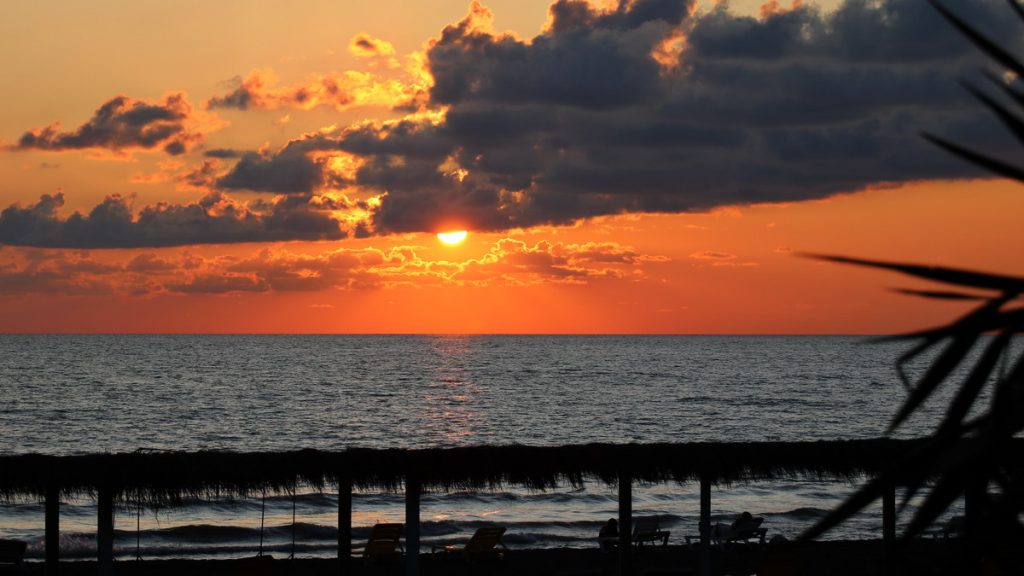
Peter had problems with his stomach again, this time he was not able to hold any liquids, and it was time to have professional help. Our travel insurance had no doctor recommendation at the Black Sea and we asked for help in the reception. So instead of going on the boat tour to Kolkheti national park, Peter was taken by ambulance to the public hospital in Poti, and given several injections in combination with IV fluids. Helle went with Peter to the hospital and the boys needed to stay at the hotel (prohibided from swimming in the pool or at the sea). The hospital staff was friendly, but didn’t speak any English. Google translate didn’t work as the translation from georgian to english was in georgian letters. We didn’t know what they were treating for, or how long the stay at the hospital should be. And as the hospital was not clean and lacked basic facilities as toilet paper, we wanted the stay to be as short as possible. So after four hours of anxious waiting, Peter was released with prescripted medicine and we catch a taxi back to the hotel. We were relieved, but Peter was not feeling any better.
The boys has been extremely bored, so Helle took the boys to the beach and made the best of the rest of the day. The beach by the hotel had indeed black sand.
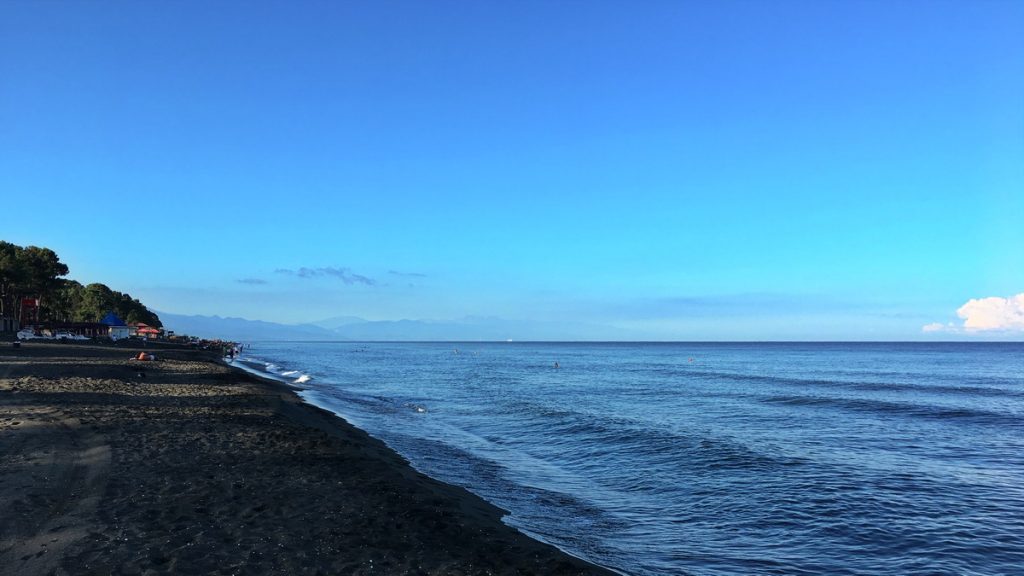
Day 16-18: Drive to Vardzia, Vardzia caves
We were very much in doubt if we should continue our travel with Peter being sick. Peter could only hold liquids inside and was febrile. As the Kolkhida Resort and Spa was so worn down and the food very bad we descided to leave the Black Sea and continue our travel in order to get closer to Tblisi, were we knew we could get a better medical treatment.
We drove towards Vardzia in the Lesser Caucasus. We wanted to go there for the Vardzia caves, but also to experience lesser Caucasus. It was a good decision, because that part of Georgia was very different from the places we had already been. There were very few abandoned buildings, everything was better maintained and just looked better.
The drive along the main east-west road is not very interesting, but as soon as you go south the landscapes become interesting. While Greater Caucasus is green and wet Alpine terrain, Lesser Caucasus is dry, looking almost like desert.
On the way, you pass the area of Borjomi, which is also the brand of the most common sparkling water served in Georgia. A beautiful green, mountainous area where we could easily have made a long stop to go walking. But as it was a long drive and Peter was sick, we headed directly to the place we had booked for three nights, Vardzia Resort. Vardzia Resort was an exceptionally delightful place to stay. The building and interiors is of high standards, and it is located in a park-like garden with small walks and many places to sit and relax. The breakfast and restaurant are of high standard.
Vardzia resort is located within eyesight of the Vardzia Caves Archeological site, the main attraction of the area. Vardzia caves is the place of a historical settlement, so it has similarities to Uplistsikhe (day 7).
A main difference is that Vardzia is built on the side of the hill, and the caves are above each other. Paths and ladders have been built for access to the caves. For the kids it meant less possibilities to run and explore – they preferred Uplistsikhe for that reason.
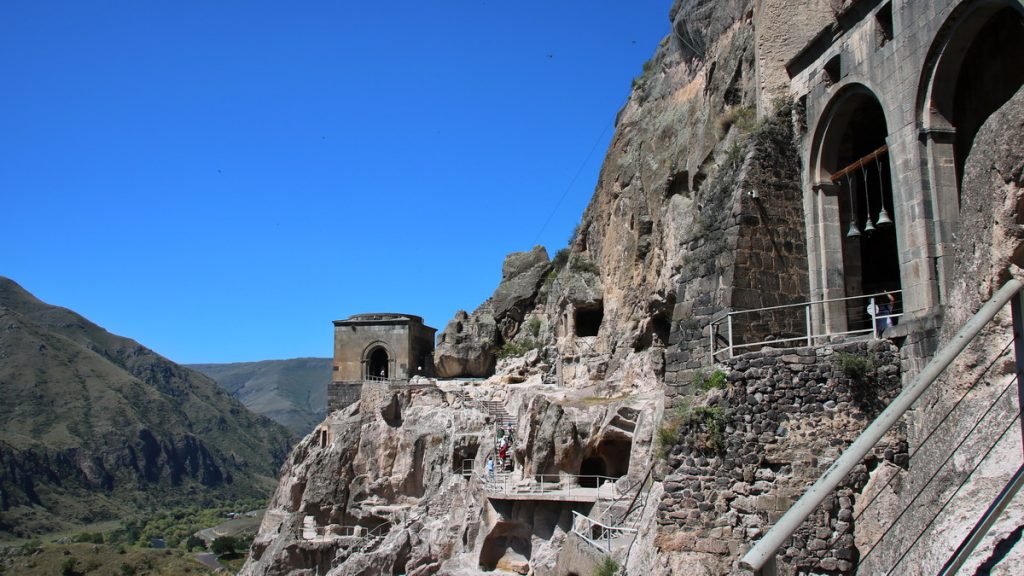
There are other places of interest in the area, in particular ruins of castles. We would have visited them if Peter had not been sick.
The area around Vardzia is absolutely worth visiting on a trip to Georgia.
Day 19 –20: Return to Tblisi and the return-flight to Denmark
We spent the last days driving back to Tblisi, returning the car and flying out at 2 AM with Air Baltic via Riga. We had fun zip-lining from the mountain where the Mother of Georgia statue stands.
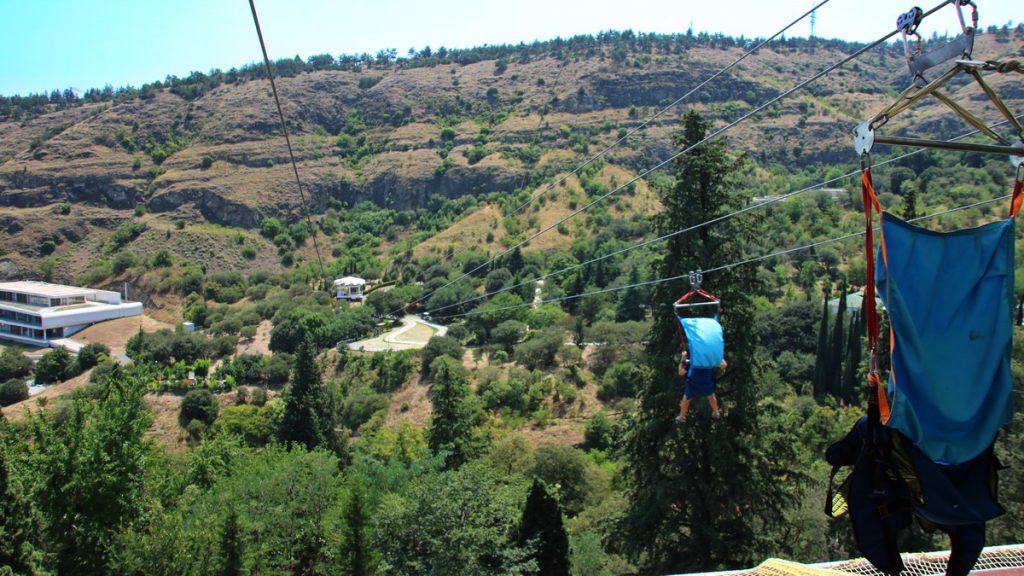
We hope you found our itinerary for a three-week road trip in Georgia useful. You’re welcome to comment below.
